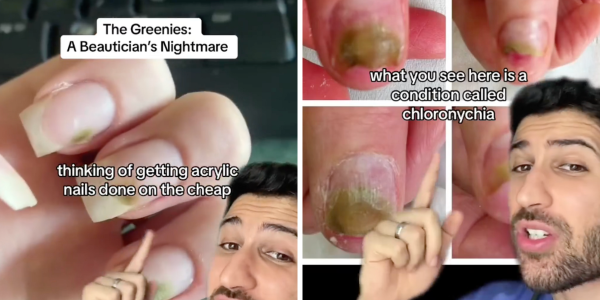Doctor reveals how acrylic nails could cause a nasty infection!
By
VanessaC
- Replies 10
For some, the allure of acrylic nails is undeniable.
They're a quick and easy way to achieve a polished, stylish look.
However, a UK-based general physician, Dr Sermed Mezher, has issued a stark warning about the potential dangers of acrylic nails.
The doctor cautioned that acrylic nails, if not applied correctly, can lead to a nasty infection that turns your nails green, a condition known 'green nail syndrome'.
The condition, also known as chloronychia, is a nail infection caused by the bacterium Pseudomonas aeruginosa.
Warning: The images below may not be for those with weak stomachs.
This bacterium thrives in moist environments and can easily seep into the gap left between the natural nail and the acrylic if the fake nails are not applied correctly.
The result? A crusty, green nail bed that can take between one to four months to grow out, even with treatment.
Dr Mezher warned, 'Think of getting acrylic nails done on the cheap? Think again.'
He then showed images of a woman's nails, which have turned green after a manicure.
'Beyond being unsightly, they [green nails] can actually be a big problem as it can take between one to four months for the nail actually to grow out, even with treatment.'
You can watch Dr Mezher’s video below, but consider this our last warning, as the images on the video are not for those with weak stomachs:
Video source: Instagram/@drsermedmezher.
While green nail syndrome is primarily a cosmetic concern, the Pseudomonas aeruginosa bacterium can pose more serious health risks.
In rare cases, it can transfer from your nail to other body parts, leading to more severe infections.
Earlier this year, a deadly strain of Pseudomonas aeruginosa in contaminated eye drops led to three deaths, eight cases of vision loss, and four eyeball removals in the United States.
Preventing Green Nail Syndrome
To minimise the risk of infection, Dr Mezher advised vigilance during the acrylic nail application process.
Furthermore, ensuring proper hygiene is crucial.
This includes ensuring nail technicians wash their hands regularly and use clean tools for every customer.
Lastly, by allowing the acrylic nails to fully dry, you also lessen the risk of bacterial growth.

While acrylic nails can be a fun way to express your personal style, it's important to be aware of the potential risks. If you notice any changes in your nails, such as discolouration or pain, it's important to seek medical advice.
Have you ever experienced a nail infection after getting acrylics? Share your experiences and tips for avoiding such issues in the comments below.
They're a quick and easy way to achieve a polished, stylish look.
However, a UK-based general physician, Dr Sermed Mezher, has issued a stark warning about the potential dangers of acrylic nails.
The doctor cautioned that acrylic nails, if not applied correctly, can lead to a nasty infection that turns your nails green, a condition known 'green nail syndrome'.
The condition, also known as chloronychia, is a nail infection caused by the bacterium Pseudomonas aeruginosa.
Warning: The images below may not be for those with weak stomachs.
This bacterium thrives in moist environments and can easily seep into the gap left between the natural nail and the acrylic if the fake nails are not applied correctly.
The result? A crusty, green nail bed that can take between one to four months to grow out, even with treatment.
Dr Mezher warned, 'Think of getting acrylic nails done on the cheap? Think again.'
He then showed images of a woman's nails, which have turned green after a manicure.
'Beyond being unsightly, they [green nails] can actually be a big problem as it can take between one to four months for the nail actually to grow out, even with treatment.'
You can watch Dr Mezher’s video below, but consider this our last warning, as the images on the video are not for those with weak stomachs:
Video source: Instagram/@drsermedmezher.
While green nail syndrome is primarily a cosmetic concern, the Pseudomonas aeruginosa bacterium can pose more serious health risks.
In rare cases, it can transfer from your nail to other body parts, leading to more severe infections.
Earlier this year, a deadly strain of Pseudomonas aeruginosa in contaminated eye drops led to three deaths, eight cases of vision loss, and four eyeball removals in the United States.
Preventing Green Nail Syndrome
To minimise the risk of infection, Dr Mezher advised vigilance during the acrylic nail application process.
Furthermore, ensuring proper hygiene is crucial.
This includes ensuring nail technicians wash their hands regularly and use clean tools for every customer.
Lastly, by allowing the acrylic nails to fully dry, you also lessen the risk of bacterial growth.
Key Takeaways
- A family doctor has warned women against using cheap acrylic fake nails as they can lead to an infection that turns your nails green.
- Incorrect application of false nails can cause bacteria to grow in the gap between the nail and the acrylic, leading to chloronychia or green nail syndrome.
- Prevention of such infections involves ensuring proper hygiene during the nail application process, making sure the nail technician is regularly washing their hands, using clean tools for every customer and allowing the acrylic nails to fully dry.
- The bacterium causing green nail syndrome, Pseudomonas aeruginosa, could, in rare cases, transfer from your nail to other parts of your body, leading to further infections.
Have you ever experienced a nail infection after getting acrylics? Share your experiences and tips for avoiding such issues in the comments below.
Last edited by a moderator:







